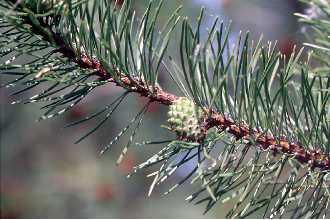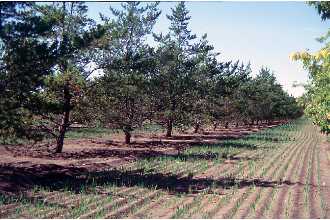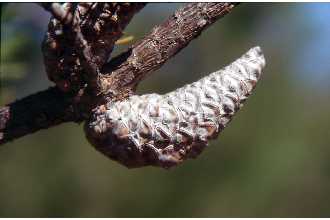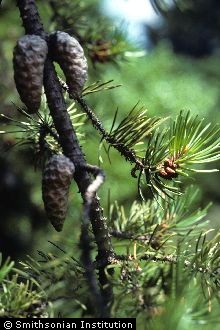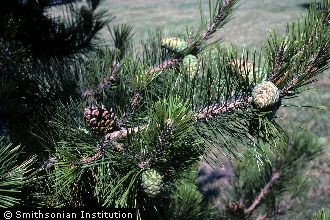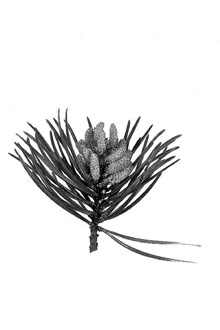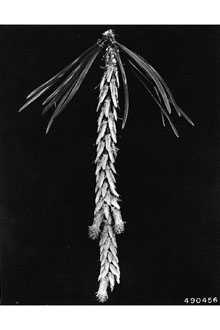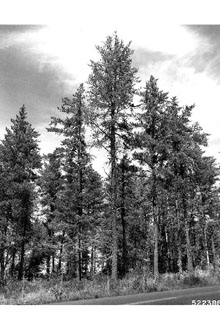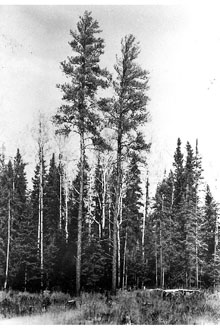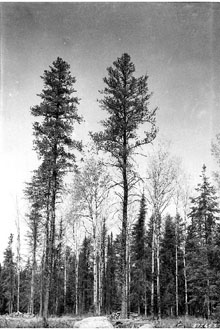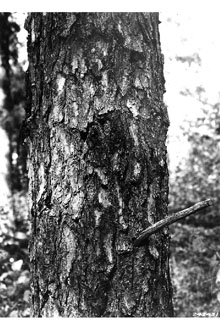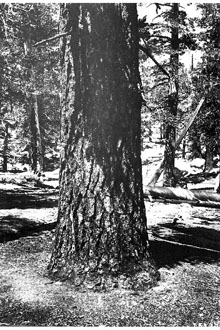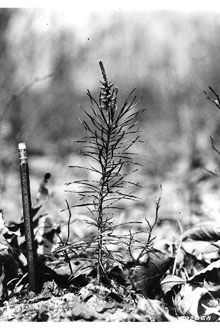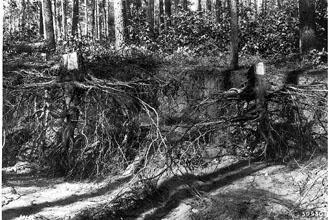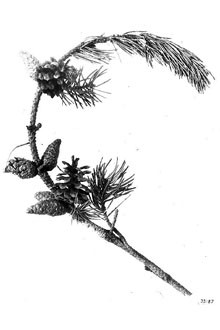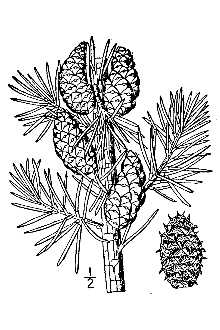Jack Pine
Scientific Name: Pinus banksiana Lamb.
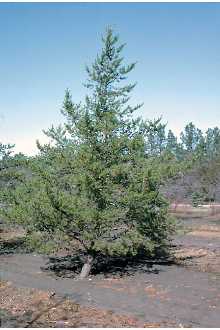
| General Information | |
|---|---|
| Usda Symbol | PIBA2 |
| Group | Gymnosperm |
| Life Cycle | Perennial |
| Growth Habits | Tree |
| Native Locations | PIBA2 |
Plant Guide
Uses
Ethnobotanic use. Canadian Indians used jack pine wood as frames in their canoes. Commercial uses: Jack pine is important timber species in the Lake States of the United States and Canada. These trees produce pulpwood, lumber for construction, telephone poles, fence posts, mine timbers, and railroad ties. Jack pine is used as Christmas trees and for stabilization of watersheds. Wildlife uses: Serves as habitat and breeding area for the endangered Kirtland's warbler (Dendroica kirtlandii), federally endangered bird. These small birds utilize jack pine stands ranging from 1.5 and 6 m (5 to 20 ft) tall larger than 32 ha (80 acres) as nesting grounds. White-tailed deer (Odocoileus virginianus) browse saplings and young trees and snowshoe hares (Lepus americanus) feed on young seedlings. Porcupines (Erethizon dorsatum) feed on bark that often leads to deformed trees. Red squirrels (Tamiasciurus hudsonicus), chipmunks (Eutamias spp.), mice (Peromyscus leucopus), goldfinches (Carduelis tristis), and robins (Turdus migratorius) consume seeds.
Status
Please consult the PLANTS Web site and your State Department of Natural Resources for this plant’s current status (e.g. threatened or endangered species, states noxious status, and wetland indicator values).
Description
General: Jack pine is a small to medium-sized, native, evergreen tree averaging 17 - 20 m (55 - 65 ft) high, Crown small, irregularly rounded or spreading and flattened irregular, Branches descending to spreading-ascending, poorly self-pruning; twigs slender, orange-red to red-brown, aging gray-brown, rough, Cones are retained for several years, resulting in a coarse appearance, Trunk straight to crooked; bark at first dark and scaly, later develops scaly ridges, Branchlets are yellow to greenish-brown when young, then turning gray-brown with age; very resinous buds, The leaves are evergreen, 2 - 3,75 cm (,75 - 1,5 in) long, and two twisted, divergent needles per fascicle, yellow-green in color all surfaces with fine stomatal lines, margins finely serrulate, apex acute to short-subulate, Fascicle sheath is short 0,3-0,6 cm, semipersistent, Seeds are compressed-obovoid, oblique; body 4-5 mm, brown to near black; wing 10-12 mm, 2n=24 The minimum seed-bearing age of open-grown jack pine is 3 to 5 years old, Some seed is produced every year and serotinous cones accumulate in the crown, A mature stand of jack pine may have as many as 2 million seeds per acre (5 million/ha) stored in unopened cones, Because of abundant seed production, few mature trees are necessary to regenerate a stand, The serotinous cones are sealed close with a resinous bond that requires high temperatures to open and liberate the seeds, This heat is usually provided by fire, but hot, dry weather (temperatures of at 49 to 60 degrees C) also opens some cones, Use soil moisture sensors to measure the soil moisture of Jack Pine., Because temperatures required to open cones typically occur in the warmest part of the summer, survival of new germinant may be poor because of drought conditions or lack of time to become established before winter, The winged seeds are the smallest of the native North American pines and are dispersed by gravity and wind, The effective dispersal range is about 110 to 130 feet (34-40 m) or two tree heights, Seeds usually germinate rapidly after release when the 10-day mean maximum air temperature is 65 degrees Fahrenheit (18 deg C) or higher, Jack pine seeds occasionally exhibit partial dormancy, which is probably broken naturally by heat from fire, Seeds remain viable in closed cones for years, but viability decreases over time Distribution: Jack pine occurs in Canada from British Columbia to Nova Scotia; and in the United States from Illinois eastward to New Hampshire, and Maine, For current distribution, please consult the Plant Profile page for this species on the PLANTS Web site, Habitat: Widespread throughout Northwestern Ontario, jack pine is usually found on sandy soils of the Spodosol and Entisol soil orders, It also grows on loamy soils, on thin soils over the granites and metamorphosed rocks of the Canadian Shield, over limestone, on peat, and on soil over permafrost, Grows in mono-specific stands or in association with black spruce; less common in mixed woods with trembling aspen and other species,
Adaptation
Jack pine is the best adapted of all boreal conifers to fire. With medium thick bark, mature individuals have only moderate fire tolerance, but populations survive because of delayed seed release from serotinous cones, early reproductive maturity, fast growth in full sun, and preference for mineral soil seedbeds. Jack pine invades areas where mineral soil has been exposed by major disturbance such as fire. Jack pine is fire adapted and becomes a dominate species in areas that are exposed to frequently burned.
Establishment
Jack pine is regenerated by planting, direct seeding, scattering cone-bearing slash on mechanically scarified ground, or using the seed tree silviculture method combined with prescribed fire. Usually grows in dry, acidic sandy soils with a lower pH limit of 4.0, but also loamy soil, thin soil over bedrock, peat, and soil over permafrost. Does not usually grow in moderately alkaline soil, but can grow in calcareous soils up to pH 8.2 if normal mycorrhizal fungi are present. Jack pine occurs on level to gently rolling sand plains of glacial outwash, fluvial, or lacustrine origin, on eskers, sand dunes, rock outcrops, bald rock ridges, and lakeshores. At elevations between 300 to 700 m (1,000 to 2300 feet). Jack pine seeds germinate best on mineral soil or soil with less than 0.2 inch or organic matter. The organic material level can be reduced by fire or mechanical raking and disking. The slash on seedbed left by harvesting must be reduced because it will provide too much shade. Some shade might be good for germination but young Jack pine seedlings require full sunlight to become established.
Pests and Potential Problems
The jack pine budworm (Choristoneura pinus) defoliates mature jack pine. The jack pine budworm, native to North America, has a range that coincides almost exactly with jack pine, its preferred host. Root borers, root feeders, shoot and stem borers, leaf feeders, needle miners, and sucking insects affect the survival and growth of seedlings. Many other insects feed on jack pine cones. Young stands of jack pine are susceptible to defoliation by the redheaded pine sawfly (Neodiprion lecontei). Jack pine is susceptible to many fungi, diseases and rust. Cultivars, Improved, and Selected Materials (and area of origin) These materials are readily available from commercial plant sources. Contact your local Natural Resources Conservation Service (formerly Soil Conservation Service) office for more information. Look in the phone book under ”United States Government.” The Natural Resources Conservation Service will be listed under the subheading “Department of Agriculture.”
References
Argus, G.W. 1966. Botanical investigations in northeastern Saskatchewan: the subarctic Patterson-Hasbala Lakes Region. Canadian Field-Naturalist 80:119-143. Benzie, J.W. 1977. Manager’s Handbook for Jack Pine in the North Central States. USDA For. Serv., Gen. Tech. Rep. NC-32. North Central Forest Experiment Station, St. Paul, Minnesota 18 pp. Braun, E.L. 1950. Deciduous Forest of Eastern North America. Hafner Publishing, New York, New York. 596 pp. Cayford, J.H. and A. Bickerstaff. 1968. Man-made Forests in Canada. Forestry Branch Publication 1240. Canadian Department Fisheries and Forestry, Ottawa, ON. 68 pp. Cayford, J.H., Z. Chrosciewicz, and H.P. Sims. 1967. A Review of Silvicultural Research in Jack Pine. Forestry Branch Publication 1173. Canadian Department Forestry and Rural Development, Canadian Forestry Service, Ottawa, Ontario. 209 pp. Chrosciewicz, Z.. 1963. The Effects of Site on Jack Pine Growth in Northern Ontario. Canadian Department Forestry, Research Branch Publication 1015. Ottawa, Ontario. 28 pp. Critchfield, W.B.,and E.L. Little, Jr. 1966. Geographic Distributions of the Pines of the World. U.S.D.A. For. Serv. Misc. Public. 991, Washington, D.C. 97 pp. Eyre, F.H., ed. 1980. Forest Cover Types of the United States and Canada. Society of American Foresters, Washington, D.C. 148 pp. Harlow, W.M., E.S. Harrar, J.W. Hardin and F.M. White 1996. Textbook of Dendrology, 8th ed., McGraw Hill Book., New York; New York 534 pp. Little, E.L. Jr. 1971. Atlas of United States Trees. Vol. 1. Conifers and important hardwoods. U.S.D.A. For. Serv. Misc. Public. 1146, Washington, D.C. Little, E.L. Jr. 1979. Checklist of United States Trees (native and naturalized). U.S.D.A. For. Serv. Misc. Public. 541, Washington, D.C. 375 pp. Little, E.L. Jr., and W.B. Critchfield. 1969. Subdivisions of the Genus Pinus (Pines). U.S.D.A. For. Serv. Misc. Public. 1144, Washington, D.C. Mayfield, HF. 1953. A census of the Kirtland’s warbler. Auk 70:17-20. Righter, F.I., and P. Stockwell. 1949. The Fertile Species Hybrid (Pinus murraybanksiana). Madrono 10:65-69. Rudolf, P.O. 1965. Jack pine (Pinus banksiana Lamb.). In Silvics of Forest Trees of the United States. P. 338-354. H.A. Fowells, comp. U.S.D.A., Ag. Hndbk. 271. Washington, D.C. Rudolph, T.D. and P.R. Laidly. 1990. Pinus banksiana (Lamb.), Jack Pine, pp. 280-293. In R.M. Burns and B.H. Honkala (eds.), Silvics of North America, Vol. 1, Conifers, U.S.D.A. For. Serv. Agric. Handbk. 654, Washington, D.C. Rudolf, T.D. and C.W. Yeatman. 1982. Genetics of Jack Pine, U.S.D.A. Forest Service, Research Paper WO-38. Washington, D.C. 60 pp. Scotter, F.W. 1974. Distribution of Pine (Pinus spp.) in the South Nahanni and Flat Rivers Region, Northwest Territories. Canadian Journal of Forest Research 4:555-557. Prepared By: Lincoln M. Moore USDA NRCS National Plant Data Center, Baton Rouge, Louisiana Jeffrey D. Walker Wilson, Earth Team Volunteer, USDA NRCS National Plant Data Center, Baton Rouge, Louisiana Species Coordinator: Lincoln M. Moore USDA NRCS National Plant Data Center, Baton Rouge, Louisiana Edited: 27june06lmm; 060803 jsp For more information about this and other plants, please contact your local NRCS field office or Conservation District, and visit the PLANTS Web site<http://plants.usda.gov> or the Plant Materials Program Web site <http://Plant-Materials.nrcs.usda.gov> The U.S. Department of Agriculture (USDA) prohibits discrimination in all its programs and activities on the basis of race, color, national origin, sex, religion, age, disability, political beliefs, sexual orientation, and marital or family status. (Not all prohibited bases apply to all programs.) Persons with disabilities who require alternative means for communication of program information (Braille, large print, audiotape, etc.) should contact USDA's TARGET Center at 202-720-2600 (voice and TDD). To file a complaint of discrimination write USDA, Director, Office of Civil Rights, Room 326-W, Whitten Building, 14th and Independence Avenue, SW, Washington, DC 20250-9410 or call 202-720-5964 (voice or TDD). USDA is an equal opportunity provider and employer. Read about Civil Rights at the Natural Resources
Plant Traits
Growth Requirements
| Temperature, Minimum (°F) | -53 |
|---|---|
| Adapted to Coarse Textured Soils | Yes |
| Adapted to Fine Textured Soils | Yes |
| Adapted to Medium Textured Soils | Yes |
| Anaerobic Tolerance | None |
| CaCO3 Tolerance | Low |
| Cold Stratification Required | Yes |
| Drought Tolerance | Low |
| Fertility Requirement | Low |
| Fire Tolerance | None |
| Frost Free Days, Minimum | 50 |
| Hedge Tolerance | None |
| Moisture Use | Low |
| pH, Maximum | 8.2 |
| pH, Minimum | 6.0 |
| Planting Density per Acre, Maxim | 1200 |
| Planting Density per Acre, Minim | 430 |
| Precipitation, Maximum | 35 |
| Precipitation, Minimum | 15 |
| Root Depth, Minimum (inches) | 20 |
| Salinity Tolerance | Low |
| Shade Tolerance | Intolerant |
Morphology/Physiology
| Bloat | None |
|---|---|
| Toxicity | None |
| Resprout Ability | No |
| Shape and Orientation | Erect |
| Active Growth Period | Spring and Summer |
| C:N Ratio | High |
| Coppice Potential | No |
| Fall Conspicuous | No |
| Fire Resistant | No |
| Flower Color | Yellow |
| Flower Conspicuous | No |
| Foliage Color | Yellow-Green |
| Foliage Porosity Summer | Moderate |
| Foliage Porosity Winter | Moderate |
| Foliage Texture | Medium |
| Fruit/Seed Conspicuous | Yes |
| Nitrogen Fixation | None |
| Low Growing Grass | No |
| Lifespan | Short |
| Leaf Retention | Yes |
| Known Allelopath | No |
| Height, Mature (feet) | 80.0 |
| Height at 20 Years, Maximum (fee | 30 |
| Growth Rate | Rapid |
| Growth Form | Single Stem |
| Fruit/Seed Color | Brown |
Reproduction
| Vegetative Spread Rate | None |
|---|---|
| Small Grain | No |
| Seedling Vigor | High |
| Seed Spread Rate | Slow |
| Fruit/Seed Period End | Fall |
| Seed per Pound | 131040 |
| Propagated by Tubers | No |
| Propagated by Sprigs | No |
| Propagated by Sod | No |
| Propagated by Seed | Yes |
| Propagated by Corm | No |
| Propagated by Container | Yes |
| Propagated by Bulb | No |
| Propagated by Bare Root | Yes |
| Fruit/Seed Persistence | Yes |
| Fruit/Seed Period Begin | Fall |
| Fruit/Seed Abundance | High |
| Commercial Availability | Contracting Only |
| Bloom Period | Late Spring |
| Propagated by Cuttings | No |
Suitability/Use
| Veneer Product | No |
|---|---|
| Pulpwood Product | Yes |
| Post Product | Yes |
| Palatable Human | No |
| Palatable Graze Animal | Low |
| Palatable Browse Animal | Low |
| Nursery Stock Product | Yes |
| Naval Store Product | Yes |
| Lumber Product | Yes |
| Fuelwood Product | Medium |
| Fodder Product | No |
| Christmas Tree Product | No |
| Berry/Nut/Seed Product | No |

